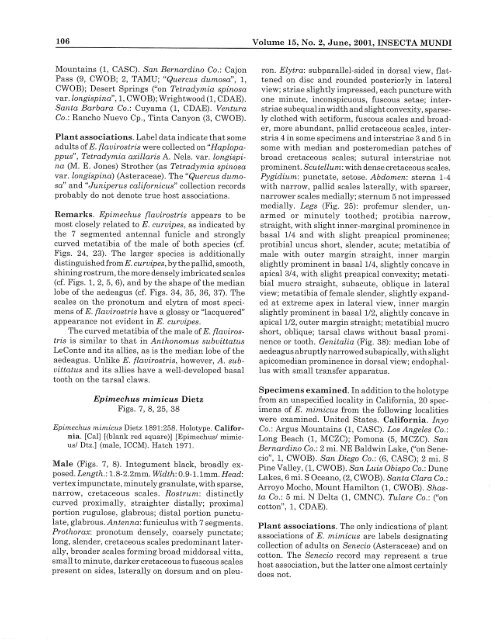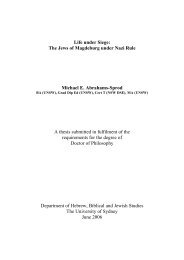Epimechus Dietz (Coleoptera: Curculionidae: Anthonomini)
Epimechus Dietz (Coleoptera: Curculionidae: Anthonomini)
Epimechus Dietz (Coleoptera: Curculionidae: Anthonomini)
Create successful ePaper yourself
Turn your PDF publications into a flip-book with our unique Google optimized e-Paper software.
106<br />
Mountains (1, CASC). San Bernardino Co.: Cajon<br />
Pass (9, CWOB; 2, TAMU; "Quercus dumosa", 1,<br />
CWOB); Desert Springs ("on Tetradymia spinosa<br />
var.longispina", 1, CWOB); Wrightwood (1, CDAE).<br />
Santa Barbara Co.: Cuyama (1, CDAE). Ventura<br />
Co.: Rancho Nuevo Cp., Tinta Canyon (3, CWOB).<br />
Plant associations. Label data indicate that some<br />
adults of E. flavirostris were collected on "Haplopappus",<br />
Tetradymia axillaris A. Nels. var. longispina<br />
(M. E. Jones) Strother (as Tetradymia spinosa<br />
var. longispina) (Asteraceae). The "Quercus dumosa"<br />
and "Juniperus californicus" collection records<br />
probably do not denote true host associations.<br />
Remarks. <strong>Epimechus</strong> flavirostris appears to be<br />
most closely related to E. curvipes, as indicated by<br />
the 7 segmented antennal funicle and strongly<br />
curved metatibia of the male of both species (cf.<br />
Figs. 24, 23). The larger species is additionally<br />
distinguished from E. curvipes, by the pallid, smooth,<br />
shining rostrum, the more densely imbricated scales<br />
(cf. Figs. 1, 2, 5, 6), and by the shape of the median<br />
lobe of the aedeagus (cf. Figs. 34, 35, 36, 37). The<br />
scales on the pronotum and elytra of most specimens<br />
of E. flavirostris have a glossy or "lacquered"<br />
appearance not evident in E. curvipes.<br />
The curved metatibia of the male of E. flavirostris<br />
is similar to that in Anthonomus subvittatus<br />
LeConte and its allies, as is the median lobe of the<br />
aedeagus. Unlike E. flavirostris, however, A. subvittatus<br />
and its allies have a well-developed basal<br />
tooth on the tarsal claws.<br />
<strong>Epimechus</strong> mimicus <strong>Dietz</strong><br />
Figs. 7, 8, 25, 38<br />
<strong>Epimechus</strong> mimicus <strong>Dietz</strong> 1891:258. Holotype. California.<br />
[Cal] [(blank red square)] [<strong>Epimechus</strong>l mimicusl<br />
Dtz.] (male, ICCM). Hatch 1971.<br />
Male (Figs. 7, 8). Integument black, broadly exposed.<br />
Length.: 1.8-2.2mm. Width: 0.9-1.1mm. Head:<br />
verteximpunctate, minutely granulate, with sparse,<br />
narrow, cretaceous scales. Rostrum: distinctly<br />
curved proximally, straighter distally; proximal<br />
portion rugulose, glabrous; distal portion punctulate,<br />
glabrous. Antenna: funiculus with 7 segments.<br />
Pro thorax: pronotum densely, coarsely punctate;<br />
long, slender, cretaceous scales predominant laterally,<br />
broader scales forming broad middorsal vitta,<br />
small to minute, darker cretaceous to fuscous scales<br />
present on sides, laterally on dorsum and on pleu-<br />
Volume 15, No.2, June, 2001, INSECTA MUNDI<br />
ron. Elytra: subparallel-sided in dorsal view, flattened<br />
on disc and rounded posteriorly in lateral<br />
view; striae slightly impressed, each puncture with<br />
one minute, inconspicuous, fuscous setae; interstriae<br />
sub equal in width and slight convexity, sparsely<br />
clothed with setiform, fuscous scales and broader,<br />
more abundant, pallid cretaceous scales, interstria<br />
4 in some specimens and interstriae 3 and 5 in<br />
some with median and posteromedian patches of<br />
broad cretaceous scales; sutural interstriae not<br />
prominent. Scutellum: with dense cretaceous scales.<br />
Pygidium: punctate, setose. Abdomen: sterna 1-4<br />
with narrow, pallid scales laterally, with sparser,<br />
narrower scales medially; sternum 5 not impressed<br />
medially. Legs (Fig. 25): profemur slender, unarmed<br />
or minutely toothed; protibia narrow,<br />
straight, with slight inner-marginal prominence in<br />
basal 1/4 and with slight preapical prominence;<br />
protibial uncus short, slender, acute; metatibia of<br />
male with outer margin straight, inner margin<br />
slightly prominent in basal 114, slightly concave in<br />
apical 3/4, with slight preapical convexity; metatibial<br />
mucro straight, subacute, oblique in lateral<br />
view; metatibia of female slender, slightly expanded<br />
at extreme apex in lateral view, inner margin<br />
slightly prominent in basal 112, slightly concave in<br />
apical 112, outer margin straight; meta tibial mucro<br />
short, oblique; tarsal claws without basal prominence<br />
or tooth. Genitalia (Fig. 38): median lobe of<br />
aedeagus abruptly narrowed subapically, with slight<br />
apicomedian prominence in dorsal view; endophal<br />
Ius with small transfer apparatus.<br />
Specimens examined. In addition to the holotype<br />
from an unspecified locality in California, 20 specimens<br />
of E. mimicus from the following localities<br />
were examined. United States. California. Inyo<br />
Co.: Argus Mountains (1, CASC). Los Angeles Co.:<br />
Long Beach (1, MCZC); Pomona (5, MCZC). San<br />
Bernardino Co.: 2 mi. NE Baldwin Lake, ("on Senecio",<br />
1, CWOB). San Diego Co.: (6, CASC); 2 mi. S<br />
Pine Valley, (1, CWOB). San Luis Obispo Co.: Dune<br />
Lakes, 6 mi. S Oceano, (2, CWOB). Santa Clara Co.:<br />
Arroyo Mocho, Mount Hamilton (1, CWOB). Shasta<br />
Co.: 5 mi. N Delta (1, CMNC). Tulare Co.: ("on<br />
cotton", 1, CDAE).<br />
Plant associations. The only indications of plant<br />
associations of E. mimicus are labels designating<br />
collection of adults on Senecio (Asteraceae) and on<br />
cotton. The Senecio record may represent a true<br />
host association, but the latter one almost certainly<br />
does not.
















